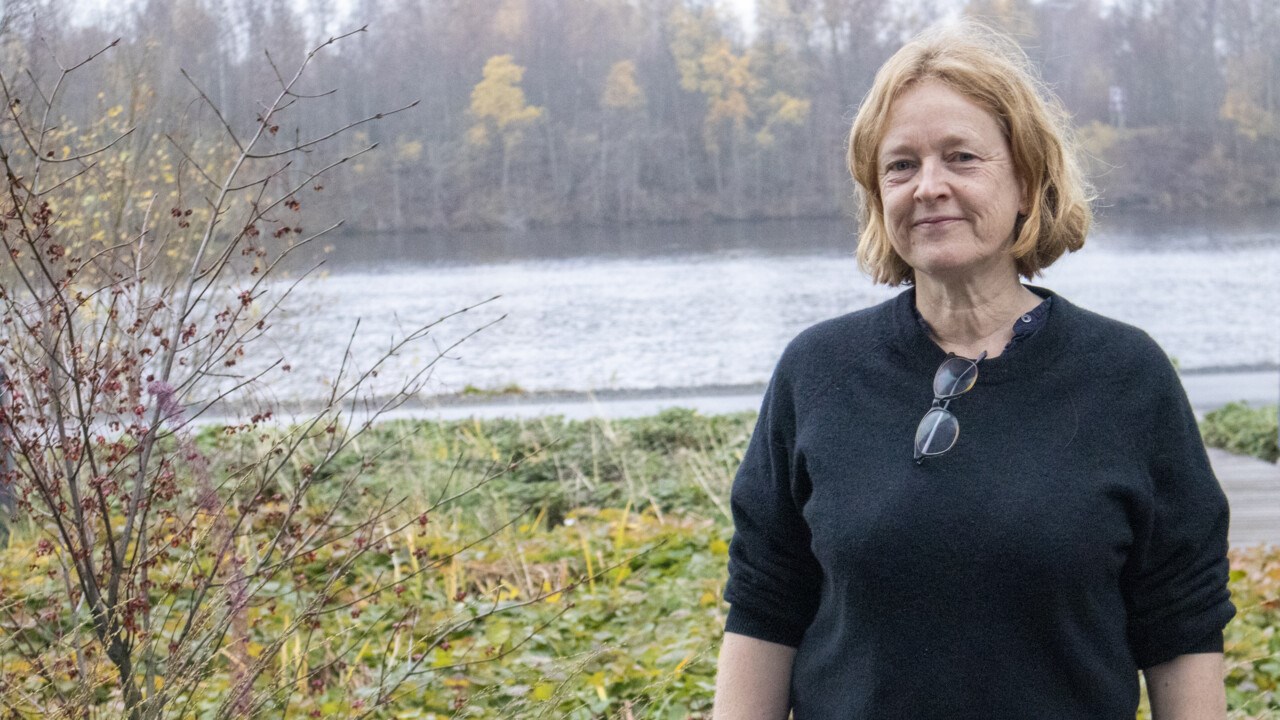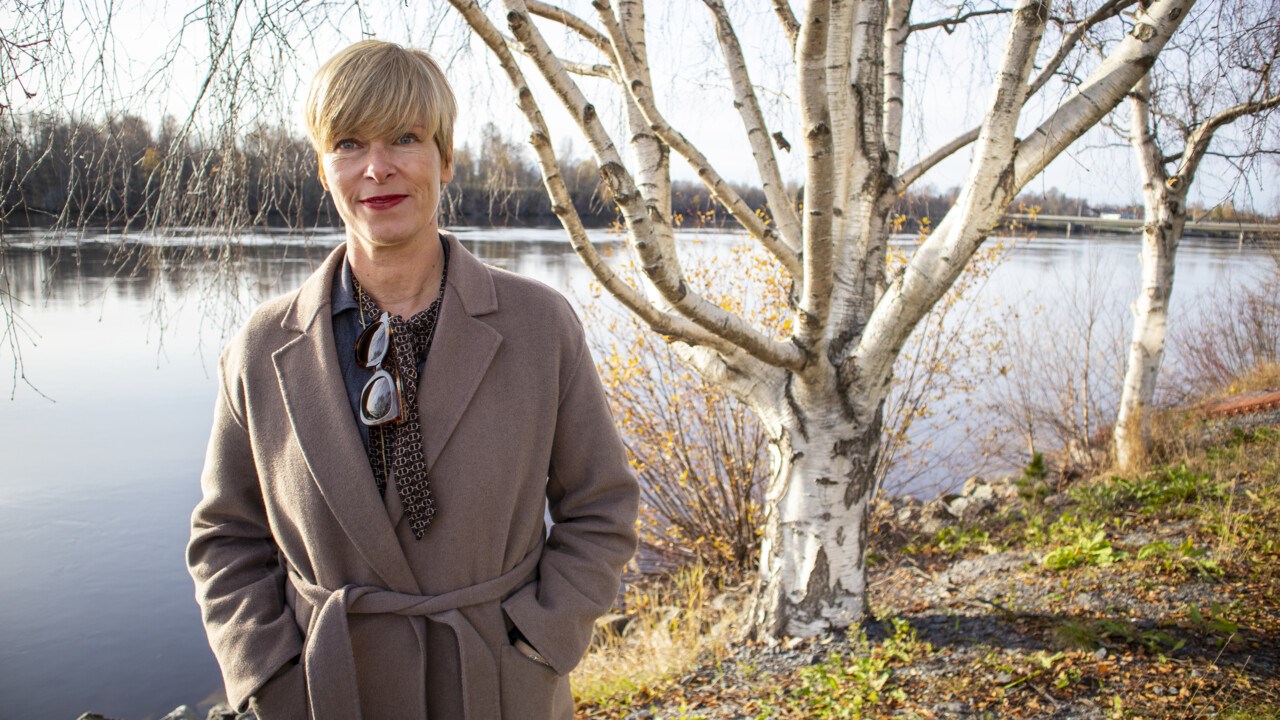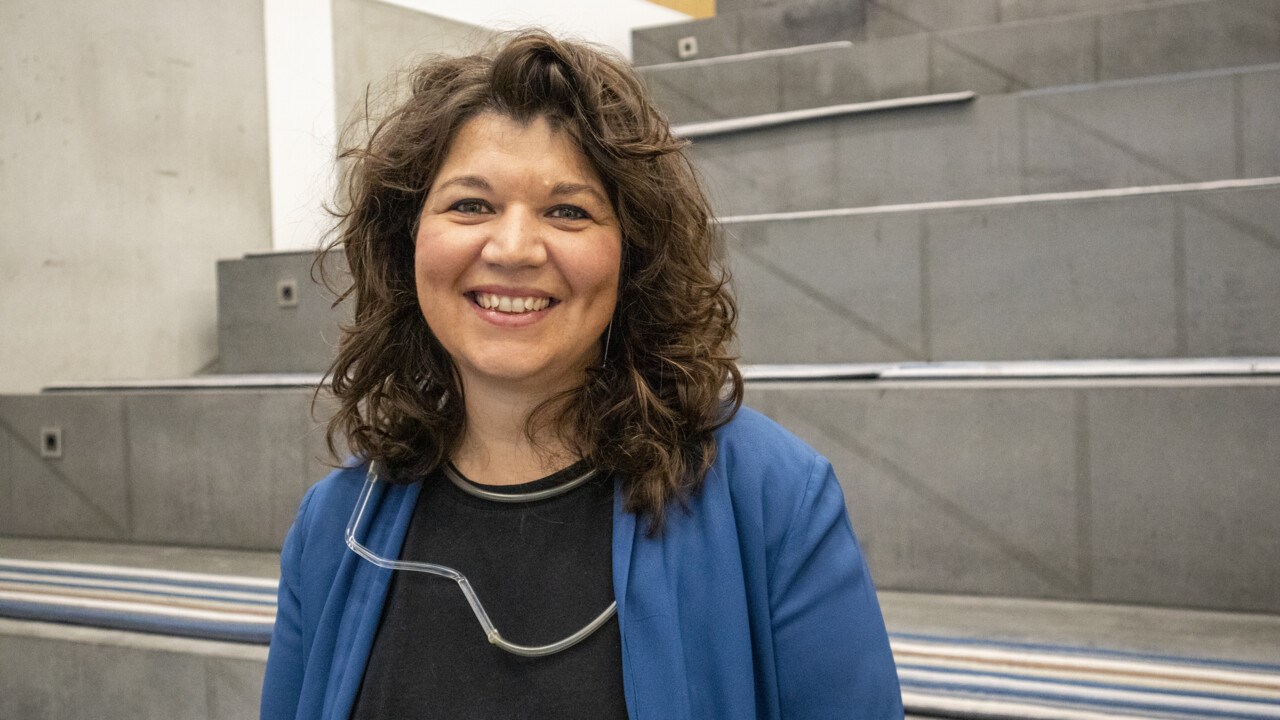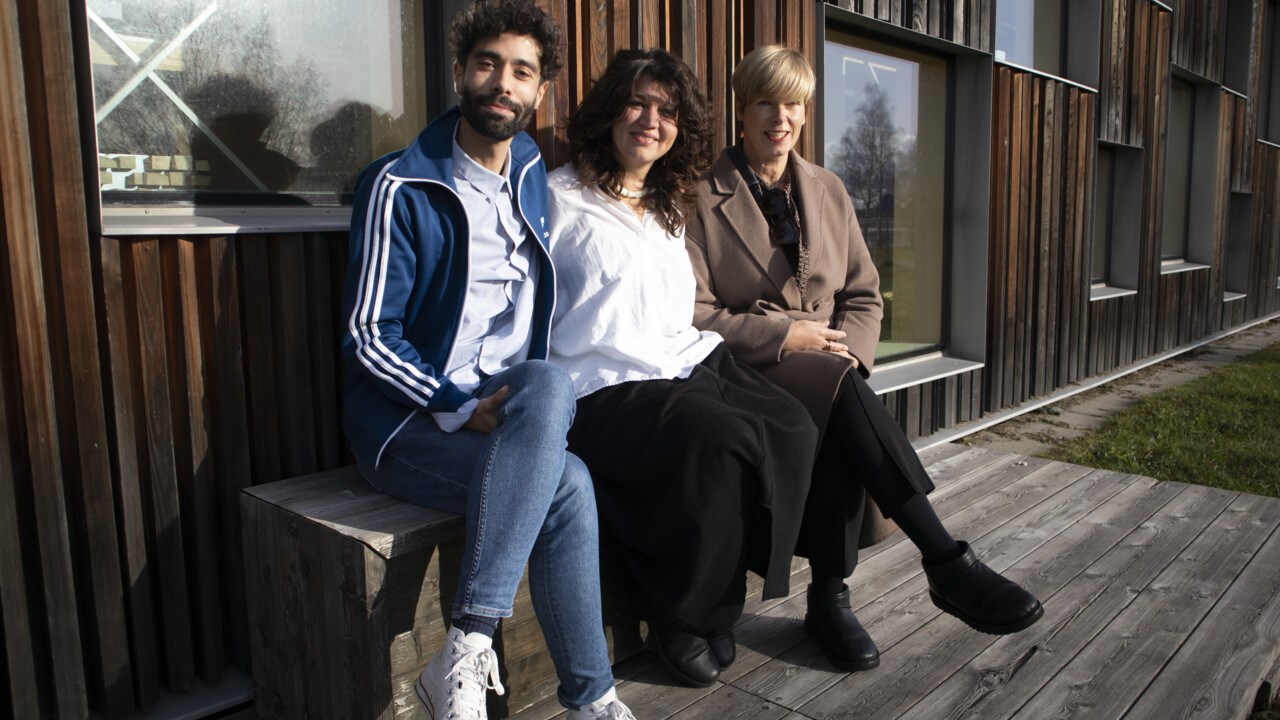ABOUT Tonia Carless
Age: 56.
From: United Kingdom.
Lives: in a rented house in Tomtebo, Umeå.
Hobbies: open air swimming, exploring Umeå by bike.

Image: Anna-Lena Lindskog
FEATURE Their research spans a wide field from urban flood management to housing in the 1900s, architectural drawings and reuse of urban industrial areas. Four newly recruited associate professors from four different countries strengthen the academic environment at Umeå School of Architecture at Umeå University, both in research and teaching.
“The school is a learning environment for me too” says Tonia Carless who teaches architectural theory. “It’s a collaborative process with both students and other colleagues where we think and discuss ideas. I also really enjoy working with young people as they are formulating their thinking about architecture and I like the idea that I’m always working with the future.”
Tonia Carless is from the UK and has a background mainly in academia, most recently at the University of the West of England in Bristol. Both Brexit and the pandemic delayed her arrival in Umeå and Umeå School of Architecture (UMA).
“I tried to move here in December 2020, but the corona virus stopped that, so I came in April.”
The school is a learning environment for me too. It’s a collaborative process with both students and other colleagues where we think and discuss ideas.

Tonia Carless.
ImageAnna-Lena LindskogShe describes her first months in Umeå as “very quiet”, only setting foot on the school premises a few times and meeting her students on Zoom. In her free time she has been exploring the city by bike and swimming in nearby lakes and by the coast.
What attracted you to UMA and Umeå?
“I think there is a different approach to social sustainability that is embedded in Swedish culture, history and politics that goes through to material sustainability as well” she says. “The idea of how cities and other spaces have developed, and things like the right to roam and the attitude to public spaces is very different to that in the UK.”
In her research Tonia Carless explores visual representations of architecture.
“One of the problems of architecture is that there is a gap between the drawing of architecture and the building itself” she says.
Negotiating that gap is always problematic, Tonia Carless argues. Things often get lost in translation, and sometimes new elements are gained in the process. Especially in architectural education drawings and models are made, but not actually built, resulting in a big space between the two.
“Any drawing or model prefigures space on the ground and this really becomes the space too, it’s almost as if the drawing becomes the site itself rather than the actual landscape” she says.
Age: 56.
From: United Kingdom.
Lives: in a rented house in Tomtebo, Umeå.
Hobbies: open air swimming, exploring Umeå by bike.

Cornelia Redeker.
ImageAnna-Lena LindskogOur biggest mistake is sealing the surface, making the ground impermeable and losing precious water.
Landscapes, climate change and urban planning have long been at the center of Cornelia Redeker’s career. Training as an architect and urban planner in Germany and the Netherlands, she did her PhD at TU Delft in an interdisciplinary project focusing on urban flood management.
After some years working with water management issues along the Rhine, she moved to Egypt to become part of a team establishing a new architectural faculty at the German University in Cairo.
“I also worked in Cairo as a design consultant and researcher. Here the topic is mainly related to water scarcity, Egypt is a largely arid environment and the Nile almost the only water source” she says.
Globally, climate change is bringing heavy rains and flooding resulting in pressing needs for adaptation in urban areas that have not been planned to manage such amounts of water.
“Our biggest mistake is sealing the surface, making the ground impermeable and losing precious water” says Cornelia Redeker. “Any street, parking lot or building is taking away the ground’s ‘sponge capacity’. In northern European cities heavy rains in a short time period and droughts in the summer are quite new, we are taken by surprise and have to pay the price for it, so there is a lot to do both in education and research to expand our strategies and increase awareness.”
New strategies can be to use more permeable building materials, to let plant covered roofs take care of rain or to find ways to store excess water for periods when it’s needed. Letting landscapes become more productive and making it possible for people in urban areas to grow their own food are other ways of adapting to the climatic challenges, she argues.
In her research at UMA she will be looking at how climate change affects the built environment. At 64° latitude it is a relatively new issue, for example Umeå municipality has just developed a new agenda for sustainable water supply.
“It is a hot topic and I hope that with my background to be able to contribute to exploring landscape-based design strategies in collaboration with partners locally and internationally, both with our students at UMA and in research.”
Age: 49.
From: Germany, but has a Swedish mother.
Lives: in an apartment Väst på stan, Umeå.
Hobbies: gardening and outdoor life, yoga, swimming and dancing.
Daniel Movilla Vega already lived in Sweden when he applied for the associate professorship at UMA. After studying architecture in Madrid and taking his PhD, which entailed guest research taking him to the Netherlands, Russia, the US and Brazil, he started working at ArkDes, the national center for architecture and design in Sweden.
“It meant a radical change in my professional life, but I felt at that moment that Sweden was the right place to be” he says.
At ArkDes he edited a book on Swedish housing in the 1900s, the period when the idea of “folkhemmet”, the people’s home, was established and implemented in extensive housing programmes to elevate living standards.
“The modern history of architecture in Sweden is different than in other countries. Due to the fact that Sweden didn’t actively participate in World War II it meant a continuity for research in housing that didn’t happen in other countries” he says. “The Swedish state had a vision on how society could be built and that was a very illuminating moment in history when politics and architecture went hand in hand.”
I would say that the notion of egalitarianism, which is a political concept, is in Sweden a spatial concept as well.
How did this political influence affect how housing developed?
“I would say that the notion of egalitarianism, which is a political concept, is in Sweden a spatial concept as well. Standards and specific measurements in houses and apartments applied to every single citizen irrespective of their socioeconomical background, thus implying there shouldn’t be a difference between one citizen and another.”
Before coming to UMA Daniel Movilla Vega conducted postdoctoral research at Luleå University of Technology. At UMA he continues his research on housing, now focusing on the architecture of domestical space and the narratives of our daily lives in these spaces. He also teaches, mainly in the master’s programme.
What do you like about teaching?
“In teaching I can articulate the ideas that I investigate in my research in a different way. The formats of research and pedagogy are different and that also allows me to look at the object I am researching from a different point of view.”
He describes his time at UMA so far as “amazing, simply amazing”.
“The first time I came to UMA, I entered the door and the place was full of students working with models and prototypes. The environment was exciting, you could really smell architecture in the air. UMA is a lively community that not only affects the teachers, it’s a community together with the students and that feeling is very, very special.”
Is it different from other architectural schools you have been in?
“Absolutely, the notion of community is tangible here. I also think the artistic component of the school makes it particularly relevant and the methodologies we use across the different years of their education make the students develop a sensitivity towards architecture I haven’t seen in any other school.”
Age: 37.
From: Spain.
Lives: in an apartment in Öbacka, Umeå.
Hobbies: running, reading and travelling.
Maria Luna Nobile from Italy also describes the feeling of community at UMA as one of the things that attracted her to the school. She had already collaborated with UMA prior to applying for the position as associate professor.
“Not only the building, which is one of the most impressive architectural schools I have ever seen, but especially the people at UMA were important to me” she says. “Each member of the team has its own background and very clear identity both in research and the approach to pedagogy, but there is a strong idea of being part of a collective that I haven´t experienced in other universities.”

Maria Luna Nobile.
ImageAnna-Lena LindskogMaria Luna Nobile trained as an architect in Naples, where she also completed her PhD and remained as a researcher and adjunct professor at the University Federico II. Her field of research is manly focused on the reuse of urban areas and buildings through innovative and experimental methods, with an attention to industrial heritage and urban commons.
Not only the building, which is one of the most impressive architectural schools I have ever seen, but especially the people at UMA were important to me.
In many cities these areas were originally built in the outskirts, but have over time become part of the urban fabric. Instead of demolishing industrial buildings that are no longer used as such, they can often successfully be reused for new purposes. There are many examples in literature of transformation of these buildings into venues for culture or housing projects, while keeping their character and architectural qualities in relation to the traces of their past, she argues.
Parallel to her academic career Maria Luna Nobile had her own practice based in Naples, as a consultant in European projects related to urban regeneration. This opened up for international research collaboration and now in Umeå, she has started grounding her research in Sweden and collaborating with researchers at Malmö University.
What courses do you teach at UMA?
“I’m responsible for Studio 3, a vertical studio that includes second and third year students with the aim of building a collective atlas based on the exploration of the city of Umeå. Currently I’m also collaborating in a new, freestanding course called “Architecture and the city – Towards another future”. It’s nice to start this new course with students coming from all over Sweden and from different backgrounds. I really believe in the idea of interdisciplinarity.
What do you like about teaching?
“What I really like is that it gives the opportunity to rethink what you already know. There is always a moment of reflection that is continuous. As educators we are transmitting knowledge, but we are learning from the students at the same time, so in this sense we can consider ourselves students as well.”
Age: 39.
From: Italy
Lives: in an apartment in central Umeå.
Hobbies: art, going to exhibitions, swimming.

Three of the four new associate professors that strengthen the academic environment at Umeå School of Architecture at Umeå University.From left Daniel Movilla Vega, Maria Luna Nobile and Cornelia Redeker.
ImageAnna-Lena Lindskog